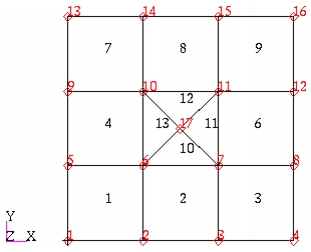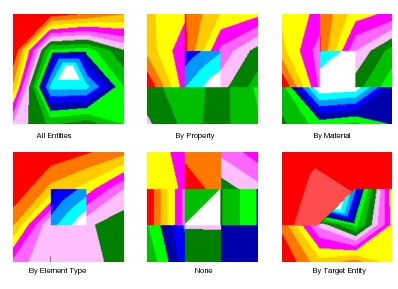
No Averaging | Each element retains its value at the element nodes. Or in other words, each element is its own averaging domain. This selection from the Averaging Domain pull down is called None. The fringe plot will have jumps (not continuous regions) at element boundaries. |
Averaging Based on All Entities | All elements will contribute to the sum and will receive the averaged result regardless of whether only certain entities have been selected for the display of the fringe plot. All surrounding elements will contribute to the averaging process. |
Averaging Based on Target Entities | Only the elements defined as the target entities will contribute to the sum and will receive the averaged result. Surrounding elements that are not part of the target entities will not contribute to the averaging process. |
Averaging Based on Materials | Elements with the same material IDs will contribute to the sum and will receive the averaged result. The fringe plot will have jumps at material boundaries. |
Averaging Based on Properties | Elements with the same property IDs will contribute to the sum and will receive the averaged result. The fringe plot will have jumps at property boundaries. |
Averaging Based on Element Types | Elements of the same type will contribute to the sum and will receive the averaged result. The fringe plot will have jumps at element type boundaries. |
Difference | The minimum and maximum results from the elements sharing a common node are computed. The difference is determined as the delta between the maximum and minimum contributor to each node. The fringe plot of this max difference indicates the quality of the mesh and the location where this mesh needs to be refined by comparing its values with the actual values of the results. Nodal results will have zero max-difference. |
Sum | The sum of all contributing nodes will be displayed. This step skips the averaging. |

Prop1 | Mat1 | Elem 1:3 |
Prop2 | Mat2 | Elem 6 8:9 |
Prop3 | Mat3 | Elem 4 7 |
Prop4 | Mat1 | Elem 10:13 |
Target1 | Elem 1:3 6 10:11 | |
Target2 | Elem 4 7:9 12:13 | |
Node | Element | Strain Energy | Averaging Domain | |||||
All | Property | Material | None | Type | Target | |||
1 | 1 | 3.01 | 3.01 | 3.01 | 3.01 | 3.01 | 3.01 | 3.01 |
2 | 1 | 3.01 | 3.89 | 3.89 | 3.89 | 3.01 | 3.89 | 3.89 |
2 | 4.78 | 4.78 | ||||||
3 | 2 | 4.78 | 3.97 | 3.97 | 3.97 | 4.78 | 3.97 | 3.97 |
3 | 3.16 | 3.16 | ||||||
4 | 3 | 3.16 | 3.16 | 3.16 | 3.16 | 3.16 | 3.16 | 3.16 |
5 | 1 | 3.01 | 8.04 | 3.01 | 3.01 | 8.04 | 3.01 | |
4 | 13.06 | 13.06 | 13.06 | 13.06 | ||||
6 | 1 | 3.01 | 4.24 | 3.89 | 2.04 | 3.01 | 6.95 | 2.63 |
2 | 4.78 | 4.78 | ||||||
4 | 13.06 | 13.06 | 13.06 | 13.06 | 6.67 | |||
10 | 0.10 | 0.19 | 2.04 | 0.10 | 0.19 | 2.63 | ||
13 | 0.27 | 0.27 | 6.67 | |||||
7 | 2 | 4.78 | 2.09 | 3.97 | 2.04 | 4.78 | 3.42 | 2.09 |
3 | 3.16 | 3.16 | ||||||
6 | 2.31 | 2.31 | 2.04 | 2.31 | ||||
10 | 0.10 | 0.11 | 2.04 | 0.10 | 0.11 | |||
11 | 0.11 | 0.11 | ||||||
8 | 3 | 3.16 | 2.74 | 3.16 | 3.16 | 3.16 | 2.74 | 2.74 |
6 | 2.31 | 2.31 | 2.31 | 2.31 | ||||
9 | 4 | 13.06 | 12.10 | 12.10 | 12.10 | 13.06 | 12.10 | 12.10 |
7 | 11.13 | 11.13 | ||||||
10 | 4 | 13.06 | 5.95 | 12.01 | 12.01 | 13.06 | 9.74 | 5.95 |
7 | 11.13 | 11.13 | ||||||
8 | 5.02 | 5.02 | 5.02 | 5.02 | ||||
12 | 0.27 | 0.27 | 0.27 | 0.27 | 0.27 | |||
13 | 0.27 | 0.27 | ||||||
11 | 6 | 2.31 | 2.11 | 3.38 | 3.38 | 2.31 | 3.38 | 1.21 |
8 | 5.02 | 5.02 | 2.70 | |||||
9 | 2.82 | 2.82 | ||||||
11 | 0.11 | 0.19 | 0.19 | 0.11 | 0.19 | 1.21 | ||
12 | 0.27 | 0.27 | ||||||
12 | 6 | 2.31 | 2.57 | 2.57 | 2.57 | 2.31 | 2.57 | 2.31 |
9 | 2.82 | 2.82 | 2.82 | |||||
13 | 7 | 11.13 | 11.13 | 11.13 | 11.13 | 11.13 | 11.13 | 11.13 |
14 | 7 | 11.13 | 8.08 | 11.13 | 11.13 | 11.13 | 8.08 | 8.08 |
8 | 5.02 | 5.02 | 5.02 | 5.02 | ||||
15 | 8 | 5.02 | 3.92 | 3.92 | 3.92 | 5.02 | 3.92 | 3.92 |
9 | 2.82 | 2.82 | ||||||
16 | 9 | 2.82 | 2.82 | 2.82 | 2.82 | 2.82 | 2.82 | 2.82 |
17 | 10 | 0.10 | 0.19 | 0.19 | 0.19 | 0.10 | 0.19 | 0.10 |
11 | 0.11 | 0.11 | ||||||
12 | 0.27 | 0.27 | 0.27 | |||||
13 | 0.27 | 0.27 | ||||||
Element | Node | von Mises Stress | Averaging Domain | |||||
All | Property | Material | None | Type | Target | |||
1 | 1 | 266353 | 266353 | 266353 | 266353 | 266353 | 266353 | 266353 |
2 | 205495 | 236621 | 236621 | 236621 | 205495 | 236621 | 236621 | |
6 | 194627 | 238950 | 263404 | 240096 | 194627 | 265783 | 209085 | |
5 | 251128 | 330989 | 251128 | 251128 | 251128 | 330989 | 251128 | |
2 | 2 | 267747 | 236621 | 236621 | 236621 | 267747 | 236621 | 236621 |
3 | 269673 | 247874 | 247874 | 247874 | 269673 | 247874 | 247874 | |
7 | 288631 | 213334 | 254218 | 199024 | 288631 | 259671 | 213334 | |
6 | 287859 | 238950 | 263404 | 240096 | 287859 | 265783 | 209085 | |
3 | 3 | 226076 | 247874 | 247874 | 247874 | 226076 | 247874 | 247874 |
4 | 223550 | 223550 | 223550 | 223550 | 223550 | 223550 | 223550 | |
8 | 216967 | 224325 | 216967 | 216967 | 216967 | 224325 | 224325 | |
7 | 219806 | 213334 | 254218 | 199024 | 219806 | 259671 | 213334 | |
4 | 5 | 410849 | 330989 | 410849 | 410849 | 410849 | 330989 | 410849 |
6 | 314864 | 238950 | 314864 | 314864 | 314864 | 265783 | 283747 | |
10 | 316307 | 310705 | 326528 | 326528 | 316307 | 350090 | 310705 | |
9 | 409360 | 381243 | 381243 | 381243 | 409360 | 381243 | 381243 | |
6 | 7 | 270577 | 213334 | 270577 | 270577 | 270577 | 259671 | 213334 |
8 | 231683 | 224325 | 231683 | 231683 | 231683 | 224325 | 224325 | |
12 | 231124 | 264210 | 264210 | 264210 | 231124 | 264210 | 231124 | |
11 | 269415 | 265760 | 311763 | 311763 | 269415 | 311763 | 206152 | |
7 | 9 | 353127 | 381243 | 381243 | 381243 | 353127 | 381243 | 381243 |
10 | 336749 | 310705 | 326528 | 326528 | 336749 | 350090 | 310705 | |
14 | 331970 | 361658 | 331970 | 331970 | 331970 | 361658 | 361658 | |
13 | 351258 | 351258 | 351258 | 351258 | 351258 | 351258 | 351258 | |
8 | 10 | 397215 | 310705 | 397215 | 397215 | 397215 | 350090 | 310705 |
11 | 389998 | 265760 | 311763 | 311763 | 389998 | 311763 | 305499 | |
15 | 384259 | 346068 | 346068 | 346068 | 384259 | 346068 | 346068 | |
14 | 391346 | 361658 | 391346 | 391346 | 391346 | 361658 | 361658 | |
9 | 11 | 275878 | 265760 | 311763 | 311763 | 275878 | 311763 | 305499 |
12 | 297297 | 264210 | 264210 | 264210 | 297297 | 264210 | 297297 | |
16 | 331799 | 331799 | 331799 | 331799 | 331799 | 331799 | 331799 | |
15 | 307878 | 346068 | 346068 | 346068 | 307878 | 307878 | 346068 | |
10 | 6 | 144769 | 238950 | 198700 | 240096 | 144769 | 198700 | 209085 |
7 | 144769 | 213334 | 143829 | 199024 | 144769 | 143829 | 213334 | |
17 | 144769 | 197728 | 197728 | 197728 | 144769 | 197728 | 143829 | |
11 | 7 | 142890 | 213334 | 143829 | 199024 | 142890 | 143829 | 213334 |
11 | 142890 | 265760 | 196756 | 196756 | 142890 | 196756 | 206152 | |
17 | 142890 | 197728 | 197728 | 197728 | 142890 | 197728 | 143829 | |
12 | 11 | 250623 | 265760 | 196756 | 196756 | 250623 | 196756 | 305499 |
10 | 250623 | 310705 | 251626 | 251626 | 250623 | 251626 | 310705 | |
17 | 250623 | 197728 | 197728 | 197728 | 250623 | 197728 | 251627 | |
13 | 10 | 252631 | 310705 | 251626 | 251626 | 252631 | 251626 | 310705 |
6 | 252631 | 238950 | 198700 | 240096 | 252631 | 198700 | 283747 | |
17 | 252631 | 197728 | 197728 | 197728 | 252631 | 197728 | 251627 | |
